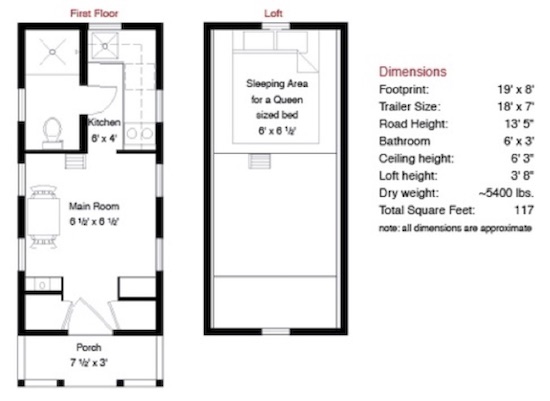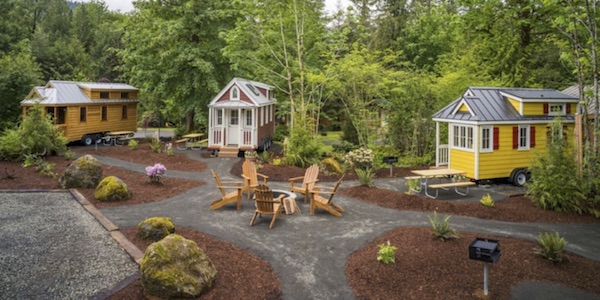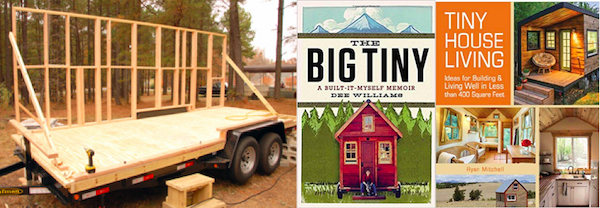Our Research Notes series invites authors to describe their process for a recent book, with “research” defined as broadly as they like. This week, Kim Hooper writes about Tiny from Turner Publishing.
+
 I first heard about tiny houses in 2014, when I read a New York Times article about Dee Willams and her 84-square-foot house. The article went viral at the time because the concept of downsizing to 84-square-feet and having so few possessions (Dee’s total was 305) seemed quite radical. I was intrigued — not just by the lifestyle, but by Dee’s story. She’d had a heart attack at the age of 40 and was diagnosed with a condition that can be fatal. The contemplation of her mortality is what motivated her to simplify her life and focus on what really matters.
I first heard about tiny houses in 2014, when I read a New York Times article about Dee Willams and her 84-square-foot house. The article went viral at the time because the concept of downsizing to 84-square-feet and having so few possessions (Dee’s total was 305) seemed quite radical. I was intrigued — not just by the lifestyle, but by Dee’s story. She’d had a heart attack at the age of 40 and was diagnosed with a condition that can be fatal. The contemplation of her mortality is what motivated her to simplify her life and focus on what really matters.
+

Dee Williams’ 84-square-foot house. Source: New York Times.
+
For a short time, I contemplated living in a tiny house myself. Then I acquired a husband and several pets and that idea was no longer practical. So, I did the next best thing — I put a character in a tiny house.
In my new novel, Tiny, Nate and Annie Forester endure one of life’s cruelest tragedies when their 3-year-old daughter is hit by a car and killed. As time passes, Nate wants to move on and return to some version of normal, while Annie finds herself stuck in the quicksand of grief. Leaving a vague note for Nate, Annie disappears from her current life to live in a tiny house community, hoping that by containing herself in 100-square-feet, she can also contain her overwhelming sadness and find peace. That’s what I think tiny houses offer their occupants — containment, a sense of safety, a cozy hug. As Dee Williams said, “I love how my current tiny house holds me.”
In Tiny, Annie’s house becomes a character in and of itself. I focused more on the design of the house than I ever have for other characters’ homes. I knew this house had meaning — both for Annie and for me, as the writer. I was living vicariously through Annie, letting her show me what happens when we strip away so much in an attempt to get to what’s real.
Annie packs very few things to bring to her tiny house life. Her choices are all about utility — basic clothing, toiletries, and kitchen items. She chooses one framed photo of her and her husband. When she can’t choose just one photo of her daughter, she takes all of them from their frames, and selects her favorite frame; she decides she’ll rotate the photos in the one frame. This is her first lesson in being clever with space.
Here is some of the description of Annie’s house when she first arrives:
It’s a simple A-frame, with a little porch and a bright red front door that seems friendlier and more welcoming of guests than she will ever be… The inside is quaint and tidy. With a straight face, James calls the entry area the ‘great room’… Beyond the great room, there’s a small galley kitchen — James correctly calls it a kitchenette — adjacent to a bathroom that’s barely big enough for an adult to stand in. ‘It’s like a phone booth,’ she said to James with a little laugh. He looked perplexed for a second. Was he too young to know what a phone booth was? Surely he’d seen pictures.
The loft with the bed is above the kitchen and bathroom, accessible only by climbing up six rungs. It’s bigger than the ‘great room.’ There are two skylights over the head of the bed that make it feel even bigger. James said, ‘If you need to get out in an emergency, like a kitchen fire or something, you’d go out through these windows.’ Somehow, Annie doubts she would get out at all in the event of a kitchen fire. In this small of a space, she’d pass out from smoke inhalation before she knew what was happening.
+

This is the house I pictured for Annie. Source: Tumbleweed Houses.
+

This is the floorplan I had in mind. Source: Tumbleweed Houses.
+

Dee Williams’ loft inspired Annie’s loft. Source: Tiny House Blog.
+
I placed Annie in a tiny house community because I wanted to see her interact with other people who had also left their more-conventional lives behind for tiny living. The members of the community build tiny houses and make money on the sales to keep their collective going. Each member is supposed to stay for a year, then leave with their own newly-built house-on-wheels.
The others in the community have their own interesting backstories, and their houses are all unique:
Matt’s house is bare, much like Annie’s. He has a beanbag chair in lieu of a couch. He uses an upside-down wooden crate as a coffee table. He has a few books, no pictures in plain sight. Dawn’s house has character… She has lace curtains on the windows, a couch covered in a magenta paisley sheet, colorful dish towels and throw pillows. Even the most mundane objects have personality — a bright-green tea kettle, a bowling-ball-and-pin salt and pepper shaker set, a table lamp in the shape of a blossoming flower. She has lots of pictures of family, lots of dishware. Every inch of space in her home is used. Ken’s house is similarly lived-in, but in different ways. He has shelves of tools, too many coffee mugs, piles of books — thrillers mostly, as far as Annie could tell. He’s messy. When Annie visited, dirty dishes were stacked in and around the sink, random articles of clothing were strewn about.”
+

This is the type of community I pictured when writing. Source: Tumbleweed Houses.
+
There were all kinds of things I learned about tiny houses when writing this book. I learned that there are minimum size requirements for houses, which is why tiny houses are put on wheels, so they’re not technically houses. If they’re on wheels, they have to be short enough to slide under freeway overpasses and skinny enough to fit in a single traffic lane. That means no wider than eight-and-a-half feet, no taller than thirteen-and-a-half feet.
My research included reading Dee Williams’ memoir, The Big Tiny, as well as Tiny House Living by Ryan Mitchell. Of course, as the tiny house movement has become more and more of a legitimate Thing, the Internet has become full of information about building and buying tiny houses. TV shows like “Tiny House Hunters” and “Tiny House Nation” also gave me great visual inspiration while I wrote.
+

The photo above of the house-in-progress is on a website that features a great, comprehensive checklist for building a tiny house. Source: The Tiny Life.
+
My husband asked me the other day if writing about tiny houses satisfied my itch to live in one. I said, “Kind of.” I still want to try one for myself. I want to lie up in a loft and watch the stars through a skylight. I have a toddler now, which really complicates my tiny house daydreams, but maybe we will rent a tiny house for a week and take her with us. It might be a few years before she can safely climb the ladder to the “bedroom” I envision, but I bet it will be worth the wait.
+++